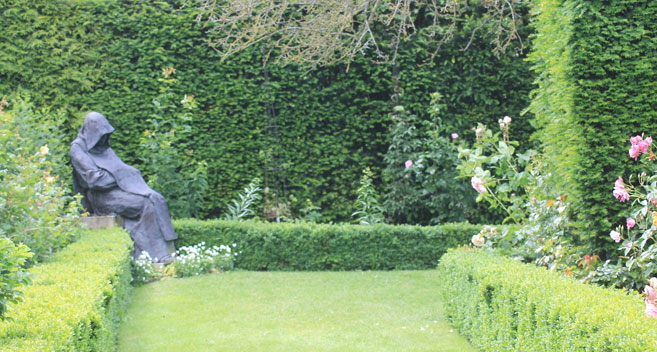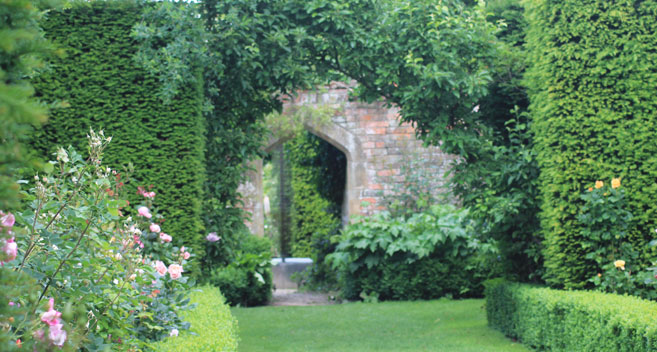
By Nick Baumber
Wanting to make the most of the Great British summer, I decided to head off and discover the historic market town of Malmesbury and explore the beautiful Abbey House Gardens.
From the very moment I walked towards St John’s Bridge on the entrance to the town, I sensed this place had many of tales to tell. The architecture of the Avon Mills building, former cloth and silk mills built in 1793 by a clothier named Francis Hill and the surrounding Cotswold stone townhouses lining the High Street, clearly reflecting Malmesbury’s trade and industrial heritage.
Crossing the bridge over the River Avon, I walked through the memorial gates into St Aldhelm’s Mead to enjoy the parkland and views across the river - a great place for a family picnic. It is understood that St Aldhelm, an early English bishop who built churches in Malmesbury and was a well-regarded figure of the town, would often sing and preach from this spot by the riverside.
Continuing my walk along the River Avon, I came across a small stone footbridge, which marks the site of Daniel’s Well, named after Daniel of Winchester, another early English bishop, who would stand up to his neck in the water for many hours in an act of self-mortification. The views across the riverbank from the path up to Malmesbury Abbey and the town are amazing.
I then made my way past the stone cottages and the First World War memorial, which stands at The Triangle and was dedicated in 1921 to remember 74 men and a local resident. Centuries ago, this was the site of a thriving market… and you can quite imagine the bustling scenes of the past here.
.jpg)
Time to head up Abbey Row, towards The Old Bell Hotel, for a spot of lunch. This is the oldest hotel in England, dating back to 1220, when Abbot Loring built a hostelry for visitors to Malmesbury Abbey. The hooded stone fireplace on the ground floor is testament to this. I met with Simon, the General Manager, who enlightened me about the building’s history, including its quirky staircase and reported hauntings. After finishing a lovely lunch (they also offer breakfast, afternoon tea and evening dining), I made my way next door to Malmesbury Abbey…. you can’t miss it!
The magnificent abbey stands tall on the hilltop overlooking the centre of the town. The 12th Century Abbey was much bigger than the remains standing today and once had a central spire, reaching 7 metres higher than the spire at Salisbury Cathedral.
.jpg)
I was given a very warm welcome on arrival at the Abbey and I learned a lot about the first king of all England - Alfred the Great's grandson, Athelstan, who reigned between 925 and 940 and made Malmesbury his home. I then found the tomb of King Athelstan, which lies in the abbey.
Athelstan was a notable and brave soldier who took York from the Danes and defeated an invasion by the king of Scotland. I learned that Athelstan was a great collector of artworks and religious relics, which he often gave away to his followers and churches to gain the support of the priesthood. I spent some time marvelling at the interesting stained glass windows, manuscripts, Norman pillars and carvings that adorned the south porch archway, before following the path back round to Abbey House Gardens.

On arrival I met with Barbara Pollard, who owns and bought Abbey House in 1994. Having spent some years renovating the gardens, Barbara was ultimately the best person to show me round the beauty of the upper gardens. As we started our tour of the gardens, which covers some 5 acres, it was clear her passion, free spirit and enthusiasm is boundless.
Barbara explained that Athelstan's body was removed from his tomb in the Abbey and placed in the gardens at Abbey House to avoid Norman desecration. She told me a little about Abbot William, who in 1260 started building a new Lady Chapel, shrine and lodgings – now Abbey House.
.jpg)
The upper, more formal gardens are lined by yew hedging and are positioned to replicate the footprint of the missing parts of the original abbey. The stunning scents and sights of the many varieties of rose, which can be found in the upper lawn gardens, were fantastic. We walked passed the statue of the monk that sits in a peaceful corner of the garden overlooking the former site of The Lady Chapel of the Benedictine Monastery, a befitting reminder to visitors of the garden’s historical connections.
We walked through the Gothic Archway to a discover large herbaceous borders, which help provide colour to the gardens throughout the year. We then moved through to the herb garden, which is surrounded by a circular colonnade covered with clematis, fruit, vines and climbing roses, which especially on these hot days provided welcome shelter from the sun. Barbara explained how “planting thyme’ provided inspiration for the layout of the herb garden.
After learning a little more about the history of the house, I was invited to explore the more informal, spiritual lower gardens on my own. Thanking Barbara, I headed off and passing the modern sculpted torsos which provided a contrast against the 13th century wall of the house on which they were displayed and down the steps.
I made my way slowly along the paths, shaded by tall trees and shrubs including magnolia, maple and rhododendrons to the river, which meanders through bottom of the garden. The tranquillity and peacefulness of the lower gardens generates a spiritual and creative space for visitors to enjoy. I carefully crossed the river via the stepping stones, stopping briefly to admire the views upstream of the gently flowing waters.
I continued along the river, to the pond and waterfall before crossing back over the river by the wooden bridge and arriving at the café to take a rest and enjoy a delicious piece of cake and a nice cool drink beside the carp pond.
After my rest, I went off to wander around the town centre to discover more that the town has to offer. This included the market cross, which is thought to date from around 1490 and the Athelstan Museum, which offers free entry and tells many of the towns historical stories, with its iron age and saxon influences and hosts changing exhibitions and displays. The museum is located in the Town Hall, which also provides a great resource for events and activities for visitors and the community. The information centre also provides valuable information on other places of local interest, including Abbey View Farm.
I’m told that Malmesbury is quite a festival town, in the sense that it offers visitors a diverse range of events and festivals both within the town and the surrounding area. This includes WOMAD, Flying Monks Arts Trail and Malmesbury’s famous carnival and festival in August and September, which culminates in a great carnival procession through the town. Leaving the museum, I took a short walk to the High Street to finish the day off exploring the many independent shops, cafes and restaurants trying to decide what gifts to buy and culinary delights to savour.
Related
Comments
Comments are disabled for this post.








 to add an item to your Itinerary basket.
to add an item to your Itinerary basket.
Must-try games:
- https://2048games.cc (Perfect for puzzle lovers)
- https://clickspacebar.com (Quick and fun)
- https://catan.topicsdirect.com (Great with friends)
Hope you enjoy these as much as I do! 🎮